Introduction
There are three species of the non-native Australian pine (Casuarina spp.) in Florida. They were introduced more than 100 years ago, so they have been present long enough to be essentially naturalized. Their spread in some areas of the state has resulted in each species being classified by the Florida Department of Environmental Protection as invasive and subject to removal according to the following: the Florida Department of Environmental Protection (FDEP) lists all Casuarina spp. as Class I Prohibited Aquatic Plants, which prohibits them from possession, collection, transportation, cultivation, and importation without a permit from the Department (62C-52.001 FAC). C. equisetifolia and C. glauca are listed on the Florida Department of Agriculture and Consumer Services' (DACS) Florida Noxious Weed List (5B-57.004 FAC). It is unlawful to introduce, multiply, possess, move, or release Florida Noxious Weeds within the state without first obtaining a permit from the DACS. Their presence in Florida and their impacts on native plant communities remains of concern; however, despite their ecological history, they are perceived as having particular benefits as well.
A review of the natural history of the Casuarina species in Florida is available on EDIS. This guide is a companion document that provides practical information and photographs to anyone interested in field identification of these plants.
Key
Casuarina species are native to Australia, where most of the important taxonomic studies have been conducted. The following key is an edited version of a seminal work on that subject (Wilson and Johnson, 1989). It presents detailed descriptions based on Australian populations of Casuarina, but local field work indicates that the information can be used for identifications in Florida.
Casuarina (Linnaeus); from the neo-Latin casuarius (cassowary), from the resemblance of the drooping branchlets to the feathers of the cassowary
Type: C. equisetifolia Linnaeus.
Trees, dioecious, monoecious in C. equisetifolia. Young, persistent branchlets differing from deciduous branchlets in shorter articles and shape or size of leaves ('teeth'). Articles terete, smooth; furrows deep and closed, concealing stomates. Leaves in whorls of 5–20. Male inflorescences simple elongate spikes; bracteoles persistent. Female inflorescences on short lateral branchlets ('peduncles') differing in appearance from the vegetative branchlets. Cones borne among or below assimilatory branchlets, pedunculate, pubescent at least when immature; bracts thin in exposed portion, not vertically expanded; bracteoles protruding from cone surface, never greatly thickened and always lacking a dorsal protuberance. Samara body glabrous, pale yellow-brown or greyish, dull.
A genus of 17 species in SE Asia, Malesia, Melanesia, Polynesia, New Caledonia, and Australia; 6 species in Australia.
1 Phyllichnia narrow and prominently angular, occasionally flattish in older growth in C. equisetifolia but then densely pubescent on phyllichnia as well as in furrows; teeth 6–10
2 Branchlets and cones ±densely and obviously pubescent; teeth 6–8, not marcescent; cone body 10–24 mm long, 9–13 mm diam.; cone bracteoles acute; samara 6–8 mm long
-
C. equisetifolia
2: Branchlets and cones sparsely and minutely pubescent; teeth 6–10, marcescent or not; cone body 7–14 mm long, 4–6 mm diam.; cone bracteoles broadly acute to acute; samara 3–4 mm long
2. C. cunninghamiana
1: Phyllichnia broad, flat or slightly rounded or with a median groove; teeth 8–20, mostly marcescent
3 Teeth 12–20; phyllichnia smooth, flat or slightly rounded; cone body 7–10 mm diam.; cone bracteoles 2.0–2.5 mm wide, thin, broadly acute, with no more than 1 obvious striation; samara 3.5–5.0 mm long
4 Teeth on young permanent shoots long-recurved
3. C. glauca
1. Casuarina equisetifolia Linnaeus
Monoecious tree 6–35 m high. Bark scaly, grey-brown to black. New shoots with teeth erect. Branchlets drooping, to 30 cm long; articles 5–13 mm long, 0.5–1.0 mm diam.; furrows usually densely pubescent; phyllichnia angular or occasionally flat in older growth, glabrous or pubescent; teeth 7 or 8, occasionally 6, erect (rarely spreading in New Guinea), 0.3–0.8 mm long, not marcescent. Male spikes 0.7–4 cm long, 7–11.5 whorls per cm; anther 0.6–0.8 mm long. Cones sparsely pubescent to tomentose; peduncle 3–13 mm long; cone body 10–24 mm long, 9–13 mm diam.; bracteoles acute. Samara 6–8 mm long. Coast Sheoak. There are 2 subspecies, subsp. Equisetifolia and incana.
2. Casuarina cunninghamiana Miquel
Tree 15–35 m high. Bark finely fissured and scaly, grey-brown. Teeth on new shoots erect. Branchlets drooping in vigorous specimens, erect in depauperate specimens; articles 4–9 mm long, 0.4–0.7 mm diam., mostly glabrous; edges of furrows often marked (when dry) by a slight ridge; phyllichnia angular to flat with a median rib; teeth 6–10, erect, 0.3–0.5 mm long, marcescent or not. Male spikes 1.2-4 cm long, 7-10 whorls per cm; anther c. 0.8 mm long. Cones ferruginous- to white-pubescent, becoming glabrous; peduncle 3–12 mm long; cone body 9–18 mm long, 7–9 mm diam.; bracteoles broadly acute. Samara 3.5–5.0 mm long. Swamp oak.
Field Identification... looking at the tree
Identification can begin with the appearance of the whole tree because certain features are reasonably consistent.
C. equisetifolia: Trees of this species are generally found in coastal locations from the middle of the state south to the Florida Keys as well as near the Everglades. In many of those sites, the trees were planted as windbreaks and for their shade. The trees often reach 40 to 50 feet or more in height, the canopy is relatively spreading and open, branches have relatively short needles that often have a "tufted" appearance and may be light-colored to yellowish. The bark is smooth and relatively thin with an obvious iron-red color beneath the bark surface and in the woody tissue. The female fruiting structures, or cones, are also distinctive for their large size and generally blocky (longer than wide) shape. Remember that this species is monoecious, and thus, if the plant has both male and female structures on it, then it is reasonably safe to conclude that it is C. equisetifolia.

C. cunninghamiana: Specimens of this species have been found in the Ruskin area, on Pine Island, in the Fort Pierce area, and north along the east coast, where they often occur singly or in small groups. Trees are also very tall (up to 60 feet or more) and somewhat spreading, with distinctive gray bark. The needles are intermediate in length among the three species and are usually a healthy-looking green; sometimes they also appear 'tufted," like the C. equisetifolia trees.
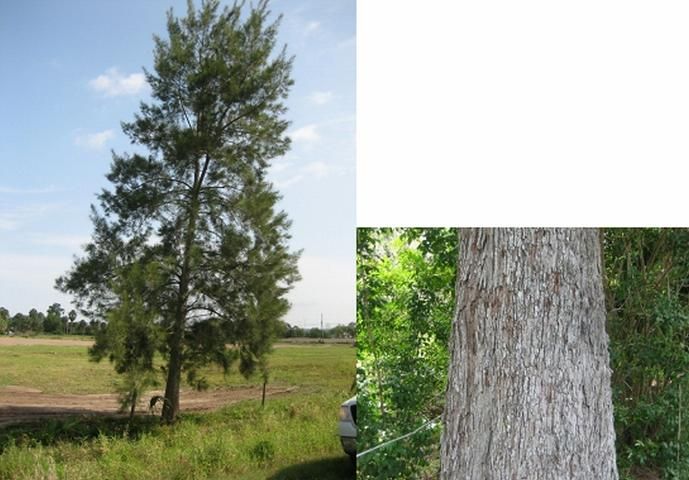
C. glauca: Trees of this species appear to be the most widely distributed, since they are easily spotted throughout central and southern Florida in thicket-like colonies that result from their spread by root suckering. They generally seem to be shorter than trees of the other two species, but they are quite distinctive because of the dense canopy of dark green needles that can be 12 inches or longer in length and because of the presence of root suckers. Among the three species, this species could easily be judged the most attractive for its appearance. Trees with cones have not been discovered within the Florida C. glauca population.
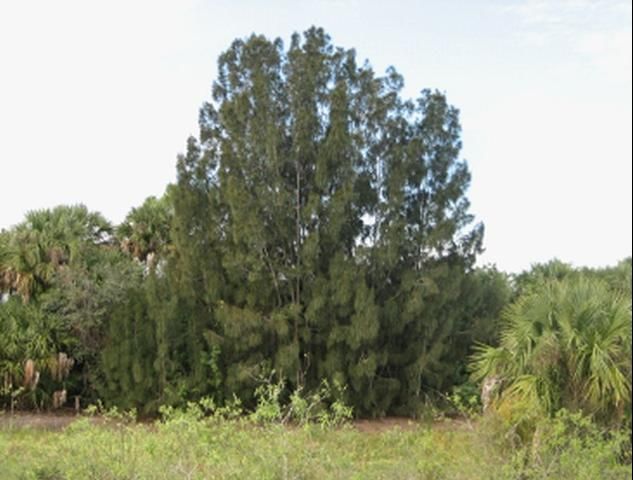
Field Identification... looking at the needle
The so-called "needle" is actually a small piece of stem encased in a whorl of greatly reduced leaves the bases of which surround or clasp the stem and terminate in a point or "tooth" at the joint (node) in the stem. The node is highly visible to the naked eye.
Examination of a needle at the node with a hand lens is revealing and can be the deciding factor for species identification; however, while that is often true, some plants are confusing because of hybrid plants among the species and other factors such as the age of the needle. Those factors should be considered when making an identification. The true species become easy to identify with practice using the traits described in Table 1. Note that there are comparable descriptions based on plants in Australia or Florida. When uncertainty arises, look at several needles on one plant and sometimes needles from different parts of that plant before making an identification.
Identification using a branch needle is easiest by using an elimination process and beginning with C. glauca.
-
The C. glauca tree is distinctive with its long, dark green foliage, and its nodal morphology clearly differentiates it from the other species. The key discriminating factor is the number of teeth. If there are obviously more than 10 to 12 small, stout-looking teeth that appear crowded around the stem, then it is this species. The teeth are usually light brown to gray with a distinctive transverse brown band at the base. The other species have fewer and larger teeth.
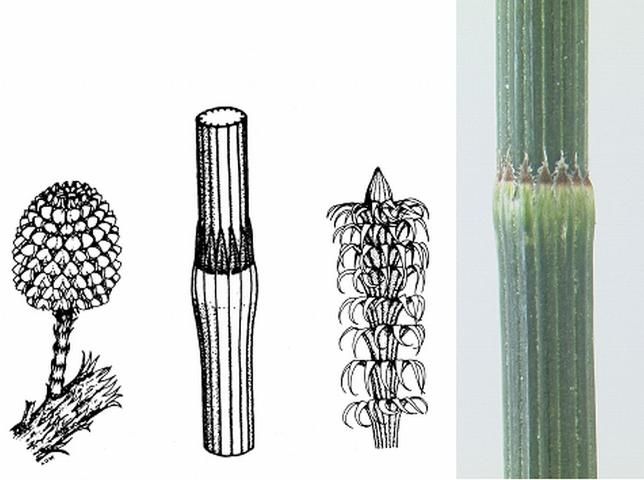
2. What easily distinguishes C. cunninghamiana are its 6 to 10 upright teeth that have light brown to gray tips with a brown transverse band about halfway between the tip of the tooth and its base.
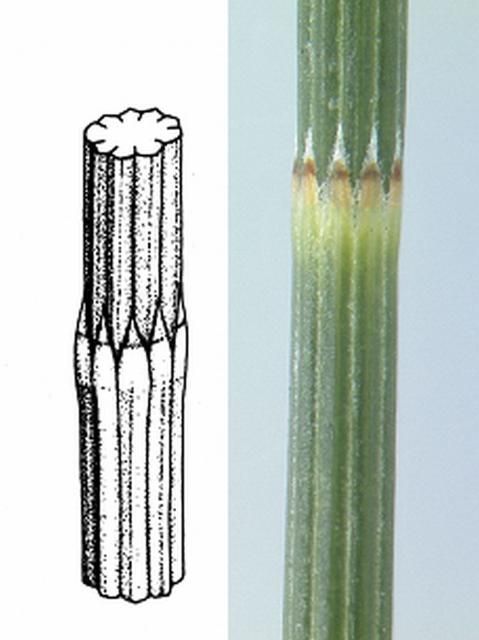

3. The easily recognized C. equisetifolia features are monoecious plants, usually prolific production of large cones, and the 6 to 8 teeth that are relatively large and light green to light yellow without any transverse banding.
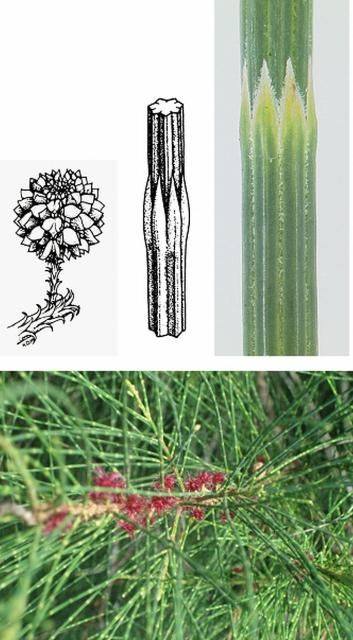
Looking at a needle with a dissecting microscope can also be helpful in examining stem cross-sections and other features.
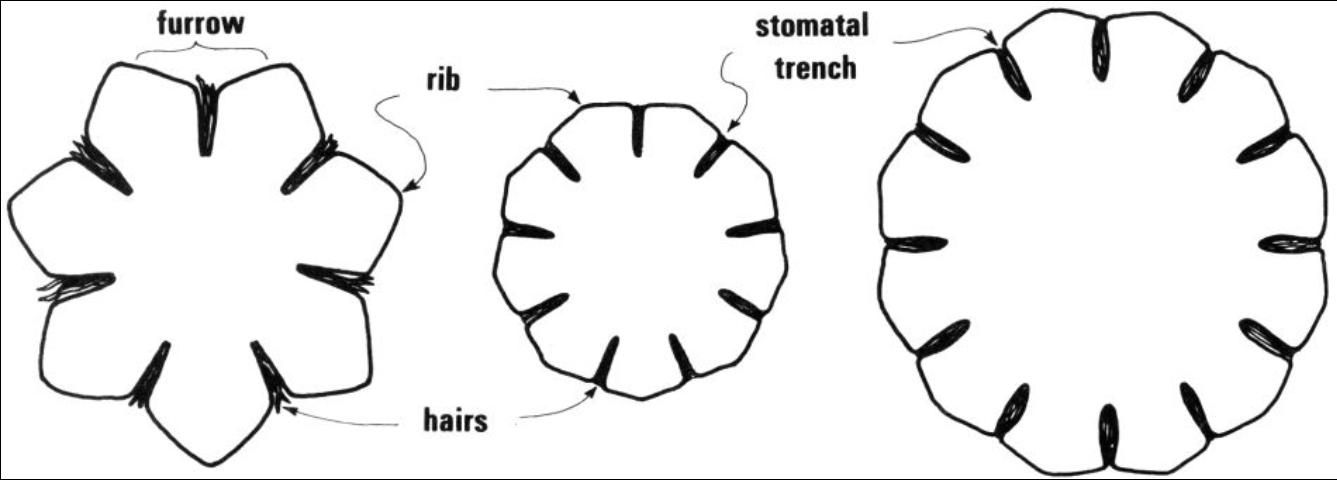
Florida Field Identification... hybrids
Until the advent of modern molecular tools, hybrids among species were suspected in Florida, but not confirmed. The most reliable observations regarding hybrids were those of Woodall and Geary (1985), and they are still relevant. In 2007, Florida samples were examined using Amplified Fragment Length Polymorphism (AFLP), a polymerase chain reaction (PCR) based genetic fingerprinting technique confirming that hybrids were present in Florida.
Summary
A suggested approach to the identification of the common Casuarina species in Florida after first gaining some familiarity with the traits described in this guide is:
-
Look at the tree, the bark, and the length and color of the needles. Check for the presence of male and female flowering structures and see if root suckers are present.
a. C. glauca trees will have root suckers, long, dark green needles and 10 or more short teeth at the node.
b. C. equisetifolia trees may have male and female flowering structures present depending on the time of year; cones are persistent and may be observed at almost any time. The number of teeth and their appearance are distinctive. The bark is relatively thin and smooth, and scraping the surface will reveal a reddish brown color underneath.
c. If none of these traits are apparent, then
2. Look at a few needles, not just one.
a. C. cunninghamiana trees have a somewhat distinctive bark; however, it is not entirely reliable for identification. The best traits are the 6–10 teeth on each needle and the transverse brown band near their middle.
3. If none of the above leads to a satisfying result, then it is likely that the plant is a hybrid.
Acknowledgments
The contents of this field guide are the result of excellent collaborations with Bob Edsall, Jr., a citrus grower in Vero Beach; and Drs. Bruce Hansen, Curator, University of South Florida; Greg Wheeler, USDA-ARS, Fort Lauderdale; John Gaskin, USDA-ARS, Sidney, Montana; and Bill Overholt, UF/IFAS, Fort Pierce.
Literature Cited
Wilson, K.L. and L.A.S. Johnson. 1989. Casuarinaceae. In: A.S. George (ed.) Flora of Australia, vol. 3. Hamamelidales to Casuarinales. Aus. Govt Printing Serv., Canberra.
Woodall, S.L. and T.F. Geary. 1985. Identity of Florida Casuarinas. USDA Forest Serv. SE Forest Expt. Stn. Res. Note SE-332.
Glossary
Article: A segment of a jointed stem.
Bract: Any reduced, leaf-like structure associated with a cone or flower.
Bracteole: A small leaf or leaves borne singly or two together and more or less opposite on the pedicel, cf. bract.
Deciduous: Plants that drop their leaves at the end of each growing season.
Dioecious: Having the male and female reproductive structures on separate plants.
Glabrous: Without hairs.
Indehiscent: A fruit that does not open when ripe to release its seeds.
Marcescent: Withering, but without falling off, cf. deciduous.
Monoecious: Having the male and female reproductive structures on the same plant.
Peduncle: The "stalk" or small stem-like portion of an inflorescence or flowering structure; a pedicel is the comparable stalk attached to a fruit.
Phyllichnium: The ridge of a branchlet article, pl. phyllichnia.
Pubescent: Covered with short, soft, erect hairs, cf. tomentose.
Samara: A dry, indehiscent fruit with its wall expanded into a wing or wings.
Terete: Cylindrical or nearly so, circular in cross-section.
Tomentose: Covered with dense, matted, woolly hairs.